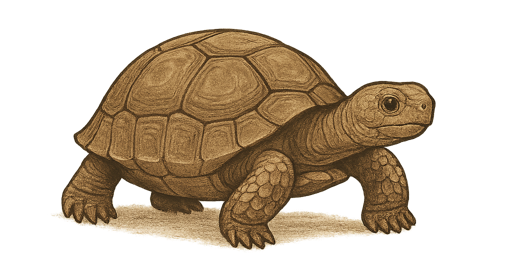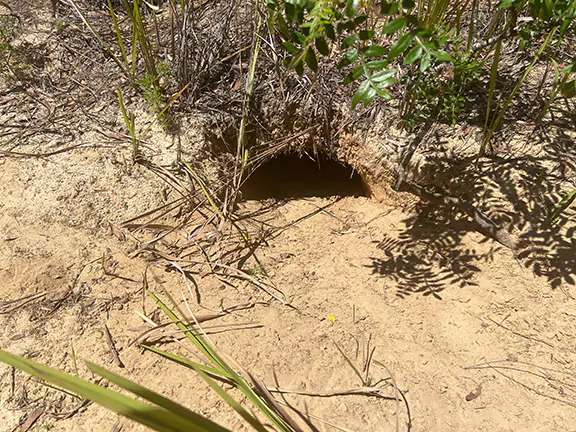If you’ve spotted a hole on your property and think it might belong to a gopher tortoise, you’re not alone. These burrows are common across Florida, Georgia, and other southeastern states where the gopher tortoise (Gopherus polyphemus) lives. But knowing whether that hole is active—or abandoned—matters more than most people realize.
Gopher tortoises are a protected, threatened species, and their burrows are legally protected under state and federal law. Disturbing an active burrow can result in heavy fines, legal issues, and damage to the surrounding ecosystem.
In this blog, we’ll break down exactly how to tell if a gopher tortoise hole is active, what to watch for, and what to do if you find one on your land.
What Makes Gopher Tortoise Burrows Unique
Understanding the Role of Gopher Tortoise Burrows in the Habitat
Gopher tortoises are known as a keystone species because their burrows provide essential shelter for over 350 other animals, including gopher frogs, small mammals, insects, rodents, and even predators. The burrow is not just a hole in the ground—it’s an entire microhabitat.
A gopher tortoise may spend up to 80% of its life underground, using its strong, shovel-like forelimbs to dig deep burrows in sandy soils. These structures regulate temperature, offer escape from fire and extreme weather, and protect against predators. Tortoises rely on these spaces year-round, especially during summer heat and winter cold snaps.
Key Characteristics of Gopher Tortoise Burrows
Half moon shape at the burrow entrance, matching the outline of the tortoise’s shell
Excavated soil forming a visible mound or “apron” in front of the entrance
Located in areas with sparse vegetation, especially in dry uplands, open woodlands, or undeveloped properties
Each burrow can be several feet deep and extend over 30 feet in length. Their appearance is usually symmetrical, clean, and well-defined if the tortoise is still using the space.
Signs That a Gopher Tortoise Hole Is Active
How to Identify Active Burrows with Visual Clues
If you’re trying to determine whether a gopher tortoise is currently using a burrow, pay close attention to the entrance and the surrounding area. Active burrows typically show the following signs:
Fresh excavated sandy soil forming a clear mound in front of the entrance
A clean, half moon–shaped opening with little or no debris
Tortoise tracks, often heading in or out of the burrow
Smooth, undisturbed walls and a clean pathway to the entrance
Evidence of use such as scat, shell marks, or recent movement of vegetation
Spotting the Tortoise Itself or Its Activity
While you might not always see the tortoise, you may notice its head near the entrance or signs that it has recently entered or exited the burrow. Scraping patterns or flattened grass around the mound may also indicate regular activity.
Even if the burrow appears empty during the day, tortoises often remain inside and surface at specific times, especially around feeding or basking hours. Late August through September can bring reduced surface activity, but that doesn’t mean the burrow is inactive.
How to Tell If a Gopher Tortoise Burrow Is Inactive or Unused
Not every burrow you find is currently in use. While gopher tortoises often return to the same locations year after year, some burrows are abandoned, sealed naturally, or reclaimed by other animals.
Visual Signs of an Inactive Burrow
If a burrow is no longer used by a tortoise, it will usually show several signs of natural decline:
Vegetation growth in or around the burrow entrance
Entrance becoming filled with dirt, leaves, or other debris
No visible mound or excavated soil (the apron may be eroded or missing)
Signs of collapse or cave-ins along the burrow’s top or sides
Lack of tortoise tracks, scat, or other evidence of movement
Inactive burrows often lose their defined half moon shape, appearing rounded or uneven. The area may also become overgrown, particularly in areas where planting or natural regeneration occurs.
Keep in mind: just because you don’t see activity doesn’t mean the burrow is empty.
Seasonal Inactivity Doesn’t Always Mean Abandonment
During parts of the year, especially in the winter or late summer, tortoises may spend extended time inside the burrow without surfacing. Sexual maturity, nesting cycles, and extreme weather can all influence their above-ground activity.
This is why it’s important not to assume a burrow is inactive based on one observation. It takes training and sometimes multiple site visits to accurately determine a burrow’s status.
Why You Shouldn’t Disturb Any Gopher Tortoise Burrow
Under Florida law, even mistakenly disturbing what appears to be an “unused” burrow may be considered molestation of a protected species. These regulations are enforced by the Florida Fish and Wildlife Conservation Commission (FWC), and violations can result in steep fines and delays to your project.
Avoid fines and costly project delays. Always contact a trained professional to determine whether the burrow is active before starting any work.

Why Active Gopher Tortoise Burrows Require Caution and a Permit
Gopher Tortoise Burrows Are Protected Under State Law
If a gopher tortoise burrow is determined to be active, it is automatically protected under Florida law. The species itself—Gopherus polyphemus—is listed as a threatened species, which means that any disturbance to the animal or its habitat is strictly regulated.
That protection includes the burrow entrance, the apron, and even the surrounding sandy soils. In other words, you don’t need to see the tortoise to be held accountable—disturbing an active burrow is enough to trigger a violation.
These laws apply to individuals and organizations like but not limited to:
Residential property owners
Commercial developers
Governmental agencies
Landscaping and construction crews
Development, Planting, or Land Work Requires a Permit
Any activity that could potentially impact an active burrow—like planting, grading, fencing, or land clearing—requires a permit from the Florida Fish and Wildlife Conservation Commission (FWC). Depending on the location and scope of the project, additional review may also be required.
To legally proceed, you must:
Confirm the presence of gopher tortoises through a professional inspection
Apply for and obtain the proper permit before beginning work
Plan for safe, humane relocation if the burrow is within a development footprint
Violating these steps—whether through ignorance or oversight—can result in steep fines, halted construction, or even legal charges.
Permitting Helps Protect Wildlife and Your Project
The permit process may seem like a hurdle, but it protects everyone involved—especially the tortoise. It ensures that no harm comes to a rare, ecologically valuable species while also giving landowners a clear path forward. Working with qualified professionals familiar with the permit system helps prevent delays and ensures compliance with state regulations.
If you’re unsure about a burrow on your property, it’s always better to get clarity before taking action.
What to Do If You Suspect an Active Gopher Tortoise Burrow
Don’t Guess—Get a Professional Inspection
If you see a burrow that has the half moon shape, a mound of excavated soil, or any signs of recent tortoise activity, it’s time to bring in a professional.
Making assumptions about whether a burrow is active or abandoned can result in costly mistakes—especially if your property is being prepped for development, planting, or any major land use changes.
A trained wildlife expert will:
Evaluate the site and determine if the burrow is currently in use
Identify potential signs of occupancy by gopher tortoises or other animals
Provide clear documentation needed for permitting or mitigation plans
Advise on whether relocation is required and how to proceed legally
Note: This isn’t something most property owners, builders, or maintenance crews can do on their own. Gopher tortoise activity isn’t always obvious—and even an “empty-looking” hole may be occupied.
Who Needs to Be Concerned About Gopher Tortoise Burrows?
Active burrows can be found in:
Residential yards
Commercial lots awaiting development
Public parks, schools, or government-owned open land
Agricultural fields, especially in sandy soils or near forest edges
Resorts and Golf Courses
If you manage or own property in Florida, you are responsible for avoiding disturbance of any protected species or their habitat. This includes not just gopher tortoises, but the ecosystems they support.
Permitting and Relocation Are Required for Legal Compliance
Once a burrow is confirmed active, any action taken near it will need to follow FWC guidelines. This includes:
Applying for a permit before proceeding with land use
Working with licensed agents to plan and conduct tortoise relocation
Avoiding disruption during sensitive times of the year, such as nesting or cooler winter months when tortoises may be deep in their burrows
Whether you’re working with private, commercial, or public land, these steps help protect the tortoise and keep your project on track.
Know the Signs, Follow the Law, Protect the Species
Spotting a burrow on your property might seem minor, but if it belongs to a gopher tortoise, it carries serious environmental and legal importance. These keystone species support entire ecosystems, and their burrows—especially active ones—are protected under state law.
Knowing how to tell if a gopher tortoise hole is active can help you make the right decisions and avoid costly mistakes. From the shape of the burrow entrance to the presence of excavated soil, tracks, or shell markings, the signs are there—but confirming activity should always be done by a professional.
Whether you’re a homeowner, developer, or government property manager, it’s your responsibility to protect threatened wildlife. The right move is simple: if you suspect an active burrow, get it inspected before starting any work.
Not sure if you have a gopher tortoise burrow on your land? Don’t risk fines or delays.
Contact Premier Gopher Tortoise Services today for professional inspection, permitting support, or safe, legal relocation assistance.
👉 Contact Us for a Free Consultation

